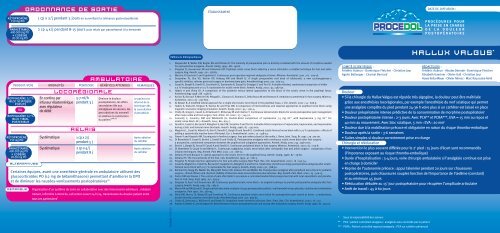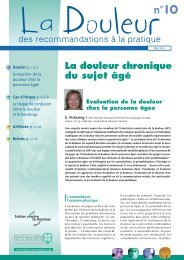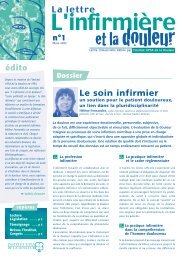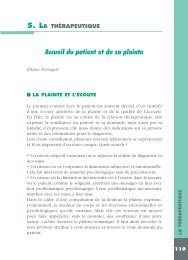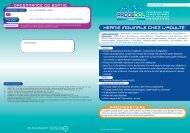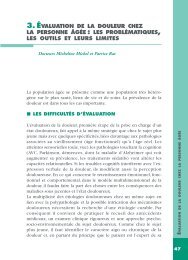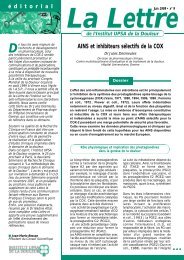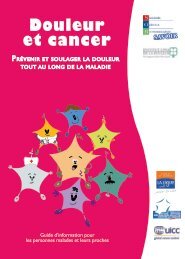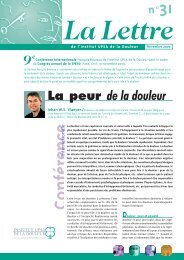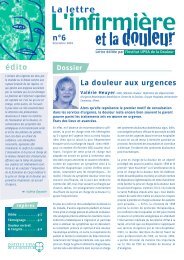Procedol : Hallux valgus - Institut upsa de la douleur
Procedol : Hallux valgus - Institut upsa de la douleur
Procedol : Hallux valgus - Institut upsa de la douleur
You also want an ePaper? Increase the reach of your titles
YUMPU automatically turns print PDFs into web optimized ePapers that Google loves.
ORDONNANCE DE SORTIE<br />
ÉTABLISSEMENT<br />
DATE DE DIFFUSION :<br />
kétoprofène<br />
150 mg po<br />
paracétamol<br />
400-500 mg PO<br />
+ codéine<br />
20-30 mg PO<br />
1 cp x 2/j pendant 5 jours en surveil<strong>la</strong>nt <strong>la</strong> tolérance gastroduodénale<br />
2 cp 4 x/j pendant 8-15 jours puis re<strong>la</strong>is par paracétamol à <strong>la</strong> <strong>de</strong>man<strong>de</strong><br />
PROCEDOL<br />
PROCÉDURES POUR<br />
LA PRISE EN CHARGE<br />
DE LA DOULEUR<br />
POSTOPÉRATOIRE<br />
PRODUIT/VOIE<br />
ropivacaïne 0,2 %<br />
bloc sciatique<br />
poplité<br />
ou<br />
ropivacaïne 0,2 %<br />
bloc tibial<br />
posterieur<br />
kétoprofène<br />
150 mg po<br />
paracétamol<br />
400-500 mg PO<br />
+ codéine<br />
20-30 mg PO<br />
ALTERNATIVES<br />
En continu par<br />
infuseur é<strong>la</strong>stomérique<br />
avec régu<strong>la</strong>teur<br />
<strong>de</strong> débit<br />
Systématique<br />
Systématique<br />
LOCORÉGIONALE<br />
5-7 ml/h<br />
pendant 3 j<br />
RELAIS<br />
1 cp x 2/j<br />
pendant 5 j<br />
2 cp x 4/j<br />
pendant 8 j<br />
AMBULATOIRE<br />
Diminue <strong>la</strong> <strong>douleur</strong><br />
postopératoire, les effets<br />
secondaires liés aux<br />
antalgiques <strong>de</strong> secours, les<br />
perturbations du sommeil<br />
et améliore <strong>la</strong> satisfaction<br />
du patient 3,26,27<br />
Certaines équipes, avant une anesthésie générale en ambu<strong>la</strong>toire utilisent <strong>de</strong>s<br />
glucocorticoï<strong>de</strong>s PO (12 mg <strong>de</strong> bétaméthasone) permettant d’améliorer <strong>la</strong> DPO<br />
et <strong>de</strong> diminuer les nausées-vomissements postopératoires 28<br />
REMARQUE<br />
MODALITÉS POSOLOGIE BÉNÉFICES ATTENDUS REMARQUES<br />
Le patient est<br />
informé <strong>de</strong> <strong>la</strong><br />
technique dès<br />
<strong>la</strong> consultation<br />
d’anesthésie<br />
Après ab<strong>la</strong>tion<br />
du cathéter<br />
Après ab<strong>la</strong>tion<br />
du cathéter<br />
Organisation d’un système <strong>de</strong> soins en col<strong>la</strong>boration avec <strong>de</strong>s intervenants extérieurs : mé<strong>de</strong>cin<br />
traitant, infirmière à domicile, call center ouvert 24 h/24, transmission du dossier patient entre<br />
tous ces partenaires 3<br />
BOXER-2540318<br />
Références bibliographiques<br />
1. S<strong>la</strong>ppen<strong>de</strong>l R, Weber EW, Bugter ML and Dirksen R. The intensity of preoperative pain is directly corre<strong>la</strong>ted with the amount of morphine nee<strong>de</strong>d<br />
for postoperative analgesia. Anesth. Analg. 1999 ; 88 : 146-8.<br />
2. Singelyn FJ, Gouverneur JM and Gribomont BF. Popliteal sciatic nerve block ai<strong>de</strong>d by a nerve stimu<strong>la</strong>tor: a reliable technique for foot and ankle<br />
surgery. Reg. Anesth. 1991 ; 16 : 278-81.<br />
3. Macaire P, Gaertner E and Cap<strong>de</strong>vi<strong>la</strong> X. Continuous post-operative regional analgesia at home. Minerva. Anestesiol. 2001 ; 67 : 109-16.<br />
4. Desjardins PJ, Shu VS, Recker DP, Verburg KM and Woolf CJ. A single preoperative oral dose of val<strong>de</strong>coxib, a new cyclooxygenase-2<br />
specific inhibitor, relieves post-oral surgery or bunionectomy pain. Anesthesiology 2002 ; 97 : 565-73.<br />
5. Casati A, Borghi B, Fanelli G, Cerchierini E, Santorso<strong>la</strong> R, Sassoli V, Grispigni C and Torri G. A double-blin<strong>de</strong>d, randomized comparison of either<br />
0.5 % levobupivacaine or 0.5 % ropivacaine for sciatic nerve block. Anesth. Analg. 2002 ; 94 : 987-90.<br />
6. Hadzic A and Vloka JD. A comparison of the posterior versus <strong>la</strong>teral approaches to the block of the sciatic nerve in the popliteal fossa.<br />
Anesthesiology 1998 ; 88 : 1480-6.<br />
7. Arcioni R, Ronconi P, Mercieri M, Pe<strong>la</strong>galli L, Ciamarra G, Romano S, Del<strong>la</strong> Rocca M and Romano R. Ambu<strong>la</strong>tory anesthesia for foot surgery. Minerva.<br />
Anestesiol. 2001 ; 67 : 797-802.<br />
8. Al-Nasser B. A modified <strong>la</strong>teral approach for a single-shot sciatic nerve block in the popliteal fossa. J. Clin. Anesth. 2002 ; 14 : 608-9.<br />
9. Hadzic A, Vloka JD, Singson R, Santos AC and Thys DM. A comparison of intertendinous and c<strong>la</strong>ssical approaches to popliteal nerve block using<br />
magnetic resonance imaging simu<strong>la</strong>tion. Anesth. Analg. 2002 ; 94 : 1321-4.<br />
10. Chelly JE, Greger J, Casati A, Al-Samsam T, McGarvey W and C<strong>la</strong>nton T. Continuous <strong>la</strong>teral sciatic blocks for acute postoperative pain management<br />
after major ankle and foot surgery. Foot. Ankle. Int. 2002 ; 23 : 749-52.<br />
11. Connolly C, Coventry DM and Wildsmith JA. Double-blind comparison of ropivacaine 7.5 mg ml (-1) with bupivacaine 5 mg ml (-1) for<br />
sciatic nerve block. Br. J. Anaesth. 2001 ; 86 : 674-7.<br />
12. Fanelli G, Casati A, Beccaria P, Al<strong>de</strong>gheri G, Berti M, Tarantino F and Torri G. A double-blind comparison of ropivacaine, bupivacaine, and mepivacaine<br />
during sciatic and femoral nerve blocka<strong>de</strong>. Anesth. Analg. 1998 ; 87 : 597-600.<br />
13. Magistris L, Casati A, Albertin A, Deni F, Danelli G, Borghi B and Fanelli G. Combined sciatic-femoral nerve block with 0.75 % ropivacaine : effects of<br />
adding a systemically inactive dose of fentanyl. Eur. J. Anaesthesiol. 2000 ; 17 : 348-53.<br />
14. Finsen V and Kasseth AM. Tourniquets in forefoot surgery: less pain when p<strong>la</strong>ced at the ankle. J. Bone. Joint. Surg. Br. 1997 ; 79 : 99-101.<br />
15. Di Bene<strong>de</strong>tto P, Casati A, Bertini L, Fanelli G and Chelly JE. Postoperative analgesia with continuous sciatic nerve block after foot surgery :<br />
a prospective, randomized comparison between the popliteal and subgluteal approaches. Anesth. Analg. 2002 ; 94 : 996-1000.<br />
16. Bertini L, Borghi B, Grossi P, Casati A and Fanelli G. Continuous peripheral block in foot surgery. Minerva. Anestesiol. 2001 ; 67 : 103-8.<br />
17. Di Bene<strong>de</strong>tto P, Casati A and Bertini L. Continuous subgluteus sciatic nerve block after orthopedic foot and ankle surgery : comparison of two<br />
infusion techniques. Reg. Anesth. Pain Med. 2002 ; 27 : 168-72.<br />
18. Zet<strong>la</strong>oui PJ and Bouaziz H. Lateral approach to the sciatic nerve in the popliteal fossa. Anesth. Analg. 1998 ; 87 : 79-82.<br />
19. Zet<strong>la</strong>oui PJ. The truncal blocks of the foot. Cah. Anesthesiol. 1993 ; 41 : 661-5.<br />
20. Singelyn FJ. Single-injection applications for foot and ankle surgery. Best Pract. Res. Clin. Anaesthesiol. 2002 ; 16 : 247-54.<br />
21. Casati A, Magistris L, Fanelli G, Beccaria P, Cappelleri G, Al<strong>de</strong>gheri G and Torri G. Small-dose clonidine prolongs postoperative analgesia after sciaticfemoral<br />
nerve block with 0.75 % ropivacaine for foot surgery. Anesth. Analg. 2000 ; 91 : 388-92.<br />
22. Reinhart DJ, Stagg KS, Walker KG, Wang WP, Parker CM, Jackson HH and Walker EB. Postoperative analgesia after peripheral nerve block for podiatric<br />
surgery : clinical efficacy and chemical stability of lidocaine alone versus lidocaine plus ketoro<strong>la</strong>c. Reg. Anesth. Pain. Med. 2000 ; 25 : 506-13.<br />
23. Porter KM and Davies J. The control of pain after Keller's procedure a controlled double blind prospective trial with local anaesthetic and p<strong>la</strong>cebo.<br />
Ann. R. Coll. Surg. Engl. 1985 ; 67 : 293-4.<br />
24. Singelyn FJ, Aye F and Gouverneur JM. Continuous popliteal sciatic nerve block : an original technique to provi<strong>de</strong> postoperative analgesia after foot<br />
surgery. Anesth. Analg. 1997 ; 84 : 383-6.<br />
25. Moore RA and McQuay Hj. Single-patient data meta-analysis of 3453 postoperative patient : oral tramadol versus p<strong>la</strong>cebo, co<strong>de</strong>ine and combination<br />
analgesics. Pain 1997 ; 69 : 287-94.<br />
26. Ilfeld BM, Morey TE, Wang RD and Enneking FK. Continuous popliteal sciatic nerve block for postoperative pain control at home : a randomized,<br />
double-blin<strong>de</strong>d, p<strong>la</strong>cebo-controlled study. Anesthesiology 2002 ; 97 : 959-65.<br />
27. Chelly JE, De<strong>la</strong>unay L, Williams B and Borghi B. Outpatient lower extremity infusions. Best Pract. Res. Clin. Anaesthesiol. 2002 ; 16 : 311.<br />
28. Aasboe V, Rae<strong>de</strong>r JC and Groegaard B. Betamethasone reduces postoperative pain and nausea after ambu<strong>la</strong>tory surgery. Anesth. Analg. 1998 ; 87 : 319-23.<br />
COMITÉ SCIENTIFIQUE :<br />
Frédéric Aubrun - Dominique Fletcher - Christian Jayr<br />
Agnès Bel<strong>la</strong>nger - Chantal Bernard<br />
HALLUX VALGUS *<br />
RÉDACTEURS :<br />
Frédéric Aubrun - Nico<strong>la</strong>s Derro<strong>de</strong> - Dominique Fletcher<br />
Elisabeth Gaertner - Olivier Gall - Christian Jayr<br />
Hawa Keita-Meyer - Olivier Mimoz - Marc Raucoules-Aimé<br />
Douleur<br />
• Si <strong>la</strong> chirurgie du <strong>Hallux</strong> Valgus est réputée très algogène, <strong>la</strong> <strong>douleur</strong> peut être maîtrisée<br />
grâce aux anesthésies locorégionales, par exemple l’anesthésie du nerf sciatique qui permet<br />
une analgésie complète du pied pendant 24-36 h voire plus si un cathéter est <strong>la</strong>issé en p<strong>la</strong>ce<br />
• Douleur préopératoire intense prédictive <strong>de</strong> <strong>la</strong> consommation <strong>de</strong> morphine postopératoire 1<br />
• Douleur postopératoire intense : 2-3 jours. Avec PCA** et PCRA***, EVA = 15 mm au repos et<br />
40 mm au mouvement. Avec bloc sciatique, 5 mm ‹ EVA ‹ 20 mm 2<br />
• Douleur due à <strong>la</strong> mobilisation précoce et obligatoire en raison du risque thrombo-embolique<br />
• Douleur après <strong>la</strong> sortie : 3-6 semaines<br />
• Suites simples si <strong>douleur</strong> correctement prise en charge<br />
Chirurgie et rééducation<br />
• Intervention le plus souvent différée pour le 2 e pied : 15 jours d’écart sont recommandés<br />
(l’impotence exposant au risque thrombo-embolique)<br />
• Durée d’hospitalisation : 3-4 jours, voire chirurgie ambu<strong>la</strong>toire si l’analgésie continue est prise<br />
en charge à domicile 3<br />
• Reprise <strong>de</strong> l’autonomie précoce : appui talonnier pendant 20 jours sur chaussures<br />
postopératoires, puis chaussures souples fonction <strong>de</strong> l’importance <strong>de</strong> l’œdème (constant)<br />
et au minimum 45 jours<br />
• Rééducation débutée au 15 e jour postopératoire pour récupérer l’amplitu<strong>de</strong> articu<strong>la</strong>ire<br />
• Arrêt <strong>de</strong> travail : 45 à 60 jours<br />
* Sous <strong>la</strong> responsabilité <strong>de</strong>s auteurs<br />
** PCA : patient controlled analgesia : analgésie auto-controlée par le patient<br />
*** PCRA : Patient controlled regional analgesia : PCA sur cathéter périneural
PROCEDOL<br />
ropivacaïne 0,5 %<br />
bloc sciatique<br />
poplité<br />
ALTERNATIVES<br />
bloc sciatique<br />
bloc à <strong>la</strong> cheville<br />
adjuvants <strong>de</strong>s<br />
anesthésiques<br />
locaux<br />
5<br />
ou<br />
Voie sciatique poplitée<br />
par voie postérieure<br />
ou <strong>la</strong>térale<br />
Différentes techniques<br />
sont décrites pour<br />
cette approche 6-10<br />
Eventuellement<br />
associé à<br />
un bloc saphène 13<br />
Eventuellement<br />
associé à<br />
un bloc fémoral 13<br />
BLOC OPÉRATOIRE<br />
20-30 ml<br />
5-10 ml<br />
20 ml<br />
PRÉOPÉRATOIRE<br />
• le val<strong>de</strong>coxib PO à <strong>la</strong> dose <strong>de</strong> 40-80 mg est proposé (hors AMM) par certains<br />
auteurs, car il retar<strong>de</strong>rait <strong>la</strong> première prise postopératoire d’antalgiques et<br />
diminuerait l’intensité <strong>de</strong> <strong>la</strong> <strong>douleur</strong> postopératoire 4<br />
PRODUIT/VOIE<br />
PROCÉDURES POUR<br />
LA PRISE EN CHARGE<br />
DE LA DOULEUR<br />
POSTOPÉRATOIRE<br />
MODALITÉS POSOLOGIE BÉNÉFICES ATTENDUS REMARQUES<br />
LOCORÉGIONALE<br />
Seule l’ALR réalisée avant<br />
l'acte chirurgical diminue<br />
l'intensité <strong>de</strong> <strong>la</strong> <strong>douleur</strong>,<br />
assure l’anesthésie<br />
peropératoire et l’analgésie<br />
postopératoire prolongée<br />
par l’utilisation d’un<br />
cathéter périneural<br />
Tolérance au garrot mollet<br />
ou cheville 13<br />
Analgésie <strong>de</strong> <strong>la</strong> face médiale<br />
du gros orteil<br />
Tolérance au garrot <strong>de</strong><br />
cuisse 13<br />
Des concentrations<br />
supérieures semblent<br />
inutiles 11<br />
Analgésie prolongée<br />
vs bupivacaïne et<br />
mépivacaïne 12<br />
Ce <strong>de</strong>rnier procure<br />
un champ opératoire<br />
exsangue et est très<br />
bien toléré par les<br />
patients, 14 le nerf<br />
saphène pouvant<br />
s’étendre jusqu’au<br />
bord médial <strong>de</strong> l’hallux<br />
Peut être réalisé sur tout le trajet <strong>de</strong> ce nerf pour <strong>la</strong> chirurgie du pied (du parasacré au<br />
bloc <strong>de</strong> cheville), mais <strong>la</strong> majorité <strong>de</strong>s équipes préfère réaliser un bloc poplité 15-18<br />
Peut être proposé pour <strong>de</strong>s actes <strong>de</strong> chirurgie mineure du pied 19<br />
Il impose plusieurs injections, souvent douloureuses et mal vécues par le patient 20<br />
• Clonidine : intérêt dans les blocs en injection unique, prolongeant leur durée d’action 21<br />
• AINS : prolongation <strong>de</strong> <strong>la</strong> durée d’action <strong>de</strong>s blocs 22<br />
• Morphiniques : prolongent peu ou pas l’anesthésie, et sont donc peu utilisés 13<br />
kétoprofène<br />
100 mg iv<br />
ALTERNATIVE<br />
néfopam<br />
20 mg iv<br />
PRODUIT/VOIE<br />
paracétamol<br />
1 g iv<br />
BLOC OPÉRATOIRE<br />
Perfusion sur 15 min<br />
à <strong>la</strong> fermeture<br />
Perfusion sur 15 min<br />
à <strong>la</strong> fermeture<br />
1 g<br />
50-100 mg<br />
Analgésie par<br />
anticipation<br />
Analgésie par<br />
anticipation<br />
Risque hémorragique<br />
20 mg sur 15 min à <strong>la</strong> p<strong>la</strong>ce du kétoprofène ou du paracétamol si contre-indication, ou associé aux 2<br />
• Pour les équipes ne pratiquant pas les blocs nerveux périphériques <strong>de</strong> façon routinière, une infiltration<br />
d’anesthésique local <strong>de</strong> longue durée d’action à <strong>la</strong> fin <strong>de</strong> l’intervention peut améliorer <strong>la</strong> DPO en termes<br />
<strong>de</strong> dé<strong>la</strong>i <strong>de</strong> prise du premier antalgique et <strong>de</strong> confort postopératoire 23<br />
ropivacaïne 0,2 %<br />
bloc sciatique<br />
poplité<br />
ALTERNATIVE<br />
ropivacaïne 0,2 %<br />
bloc sciatique<br />
poplité<br />
néfopam<br />
20 mg iv<br />
morphine<br />
1 mg/ml iv<br />
ou<br />
morphine<br />
10 mg/ml sc<br />
3<br />
3<br />
PRODUIT/VOIE<br />
15,17,24<br />
PCRA :<br />
cathéter sciatique<br />
poplité continu<br />
+ bolus<br />
En continu par infuseur<br />
é<strong>la</strong>stomérique avec<br />
régu<strong>la</strong>teur <strong>de</strong> débit<br />
Perfusion sur 15 min<br />
Perfusion <strong>de</strong> 20 mg<br />
puis 1 h après,<br />
perfusion continue<br />
PCA quand patient<br />
évaluable après<br />
titration<br />
2 h après titration<br />
5 ml/h en continu<br />
+ bolus <strong>de</strong> 5 ml<br />
Pério<strong>de</strong> réfractaire:<br />
30-45 min<br />
5-7 ml/h<br />
1 g<br />
20 mg/4 h<br />
1-3 mg/5-10 min<br />
5-10 mg/4 h<br />
Analgésie<br />
satisfaisante<br />
Analgésie<br />
<strong>de</strong> complément<br />
Analgésie<br />
<strong>de</strong> complément<br />
Entretien analgésie<br />
Entretien analgésie<br />
SSPI<br />
PCRA = résultats<br />
performants et satisfaction<br />
<strong>de</strong>s patients 17<br />
Diminue <strong>la</strong> consommation<br />
d’anesthésiques locaux<br />
vs injection continue 17<br />
L‘efficacité du bloc est testée et en cas <strong>de</strong> <strong>douleur</strong> en SSPI, les antalgiques <strong>de</strong> secours sont utilisés dans l’ordre suivant :<br />
paracétamol 1 g iv<br />
MODALITÉS POSOLOGIE BÉNÉFICES ATTENDUS REMARQUES<br />
pARENTÉRALE<br />
MODALITÉS POSOLOGIE BÉNÉFICES ATTENDUS REMARQUES<br />
LOCORÉGIONALE<br />
pARENTÉRALE<br />
Si non administré<br />
au bloc opératoire<br />
En cas d’échec<br />
du cathéter troncu<strong>la</strong>ire<br />
En cas d’échec<br />
du cathéter troncu<strong>la</strong>ire<br />
en alternative à <strong>la</strong> PCA<br />
ropivacaïne 0,2 %<br />
bloc sciatique<br />
poplité<br />
17,24<br />
PRODUIT/VOIE<br />
ALTERNATIVE<br />
ropivacaïne 0,2 %<br />
bloc sciatique<br />
poplité<br />
paracétamol<br />
1 g iv<br />
SECTEUR D’HOSPITALISATION<br />
PCRA :<br />
cathéter sciatique<br />
poplité continu<br />
+ bolus<br />
En continu par<br />
infuseur<br />
é<strong>la</strong>stomérique avec<br />
régu<strong>la</strong>teur <strong>de</strong> débit<br />
Perfusion sur 15 min<br />
Systématique<br />
Perfusion sur 15 min<br />
Systématique<br />
Perfusion sur 15 min<br />
PCA chez patient<br />
évaluable après<br />
titration<br />
A <strong>la</strong> <strong>de</strong>man<strong>de</strong><br />
Systématique<br />
LOCORÉGIONALE<br />
5 ml/h en continu<br />
+ bolus <strong>de</strong> 5ml<br />
pendant 2-3 j<br />
Pério<strong>de</strong> réfractaire :<br />
30-45 min<br />
5-7 ml/h<br />
1 g x 4/j<br />
pendant 2 j<br />
50 mg x 4/j<br />
ou 100 mg x 3/j<br />
pendant 2 j max<br />
20 mg x 4/h<br />
pendant 2 j<br />
1-3 mg/5-10 min<br />
10 mg/4 h<br />
2 cp x 4/j<br />
pendant 8-15 j<br />
Entretien analgésie<br />
Analgésie<br />
au mouvement<br />
Entretien analgésie<br />
Entretien analgésie<br />
Entretien analgésie<br />
Entretien analgésie<br />
Entretien analgésie<br />
Entretien analgésie<br />
PCRA = résultats<br />
performants et<br />
satisfaction <strong>de</strong>s patients 17<br />
Cathéter maintenu jusqu’à<br />
obtenir une <strong>douleur</strong><br />
modérée, sou<strong>la</strong>gée par<br />
antalgiques mineurs (2-3 j)<br />
PARENTÉRALE<br />
Comme précé<strong>de</strong>mment, les antalgiques parentéraux ne sont utilisés que si le bloc poplité est insuffisant et dans l’ordre suivant :<br />
kétoprofène<br />
100 mg iv<br />
néfopam<br />
20 mg iv<br />
morphine<br />
1 mg/ml iv<br />
ou<br />
morphine<br />
10 mg/ml sc<br />
paracétamol<br />
400-500 mg PO<br />
+ codéine<br />
20-30 mg PO<br />
25<br />
ALTERNATIVE<br />
paracétamol<br />
400 mg PO<br />
<strong>de</strong>xtropropoxyphène<br />
30 mg PO<br />
• TYPE DE CHIRURGIE : Objectif : réduire l’angle métatarsopha<strong>la</strong>ngien<br />
- par ostéotomie <strong>de</strong> trans<strong>la</strong>tion avec abaissement et dérotation du premier métatarsien<br />
- éventuellement ostéotomie <strong>de</strong> <strong>la</strong> 1 re pha<strong>la</strong>nge du gros orteil<br />
10<br />
25<br />
RELAIS<br />
HALLUX VALGUS<br />
MODALITÉS POSOLOGIE BÉNÉFICES ATTENDUS REMARQUES<br />
1-2 cp ou gél. x 4/j en cas <strong>de</strong> sevrage complet <strong>de</strong> <strong>la</strong> morphine<br />
Risque hémorragique<br />
En cas d’échec<br />
du cathéter troncu<strong>la</strong>ire<br />
Arrêt si consommation<br />
inférieure à 10 mg<br />
En cas <strong>de</strong> sevrage<br />
complet <strong>de</strong> <strong>la</strong> morphine


